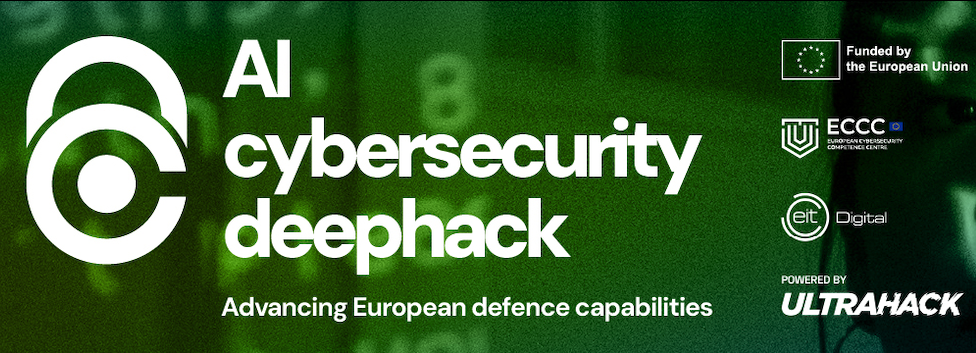AI Cybersecurity Deephack: Advancing European Defence Capabilities

Can AI Stop the Next Big Phishing Attack? Join the Challenge!
Phishing attacks are evolving, making traditional cybersecurity defenses obsolete. AI-powered solutions can bridge the gap, detecting threats before they cause damage. But can we create technology that protects both civilian and defence sectors? That’s the challenge we’re tackling at the AI Cybersecurity Deephack!
- Event Date: April 24–26, 2025
- Location: Online
- Registration Deadline: April 13, 2025
Challenge
Participants will develop an AI-driven system that detects and prevents phishing attacks in real-time. Using natural language processing (NLP), anomaly detection, and existing phishing threat intelligence sources such as OpenPhish and Google Safe Browsing API, the goal is to create a system that can analyse linguistic anomalies, user behaviours, and suspicious URLs to identify threats before they reach their target.
APPLY NOW

The solutions must protect businesses from financial fraud and data breaches and defend military and governmental institutions from cyber espionage and operational disruptions. These technologies can enhance cybersecurity resilience across both civilian and defence sectors by ensuring dual-use applications.
Dual-Use Context
Cyber threats do not differentiate between sectors. A phishing attack targeting an enterprise could lead to financial fraud, while a similar attack on a defence entity could result in intelligence leaks or operational paralysis. The challenge encourages the development of AI solutions that strengthen cybersecurity across industries by enabling better threat intelligence sharing and supply chain security.
Practical deployment challenges
Participants should be aware of:
- Addressing AI bias in phishing detection (especially for non-English attacks).
- Potential dual-use risks (e.g., offensive applications of AI-generated threat intelligence) – See regulatory frameworks above
- Data sensitivity: Defense applications require highly secure data handling, while civilian use cases may prioritize openness and collaboration: solutions must work across classified networks (e.g., military intranets) and less restrictive civilian environments.
- On-prem vs. Cloud vs. Edge computing: Military environments often require air-gapped or edge computing solutions, while civilians leverage cloud-based AI models.
- Legacy system compatibility: Defense organizations often use older infrastructure, requiring adaptable solutions.
- Latency & Real-time decision making: In defense, milliseconds can be critical (e.g., autonomous threat response), while in civilian applications, slight delays may be tolerable.
- Resilience to adversarial AI: Military applications face nation-state-level cyber threats, necessitating stronger adversarial defenses.
Concrete Examples of Dual-Use Scenarios:
- Enterprise Financial Fraud vs. Military Cyber Espionage
Attackers impersonate executives to manipulate financial transactions (Business Email Compromise, BEC), while defence agencies face phishing emails disguised as secure documents, potentially leading to spyware implantation. AI can detect language anomalies, sender behaviors, and login activity deviations to prevent both.
- Ransomware in Civilian vs. Defense Networks
A phishing attack encrypts hospital records, demanding ransom, while a similar attack disrupts classified military communications. AI-driven behavioral analysis can identify suspicious activity before it causes damage.
- Real-World Phishing Attack Affecting Both Sectors
The 2015 Anthem Inc. breach exposed healthcare records, impacting military personnel, while the 2016 DNC breach resulted in a national security data leak. AI could have mitigated both by analysing sender metadata, domain reputation, and behavioural anomalies.
When and Who Should Join?
The AI Cybersecurity Deephack will take place online from April 24 to April 26, 2025. Participants must register by April 13, 2025, to secure their spot.
Teams should consist of 2 to 5 members, with up to 12 teams selected to compete.
Individual registration is possible – you will be assigned to a team at the end of the registration process.
This Deephack is looking for:
- Start-ups, scale-ups looking for funding to enhance their cybersecurity solution
- SMEs, Corporates team testing AI applications
- Government and law enforcement tech teams focusing on cyber defense
- Cybersecurity professionals and ethical hackers
- University students specialising in AI, cybersecurity, or software development looking for Industry exposure
More Potential Solution Domains
- Email & Messaging Security – AI models that detect phishing attempts in real-time.
- Behavioural Analysis – Identifying anomalous user activities that suggest phishing.
- Natural Language Processing (NLP) – Recognizing social engineering tactics in phishing messages.
- Computer Vision-based Detection – Identifying fake login pages and phishing sites.
- Automated Threat Intelligence Sharing – Platforms that enable cross-sector phishing threat sharing.
Constraints
Solutions must be AI-powered and designed for dual-use cybersecurity applications. They should comply with data privacy regulations such as GDPR and CCPA, integrate with existing enterprise security systems and military cyber defence frameworks, and follow ethical considerations when developing AI-driven attack and defence mechanisms.
Resources
Participants will have access to publicly available datasets, including synthetic phishing attack data and insights from COcyber & ECYBRIDGE projects’ reports, highlighting key challenges in civilian-defense cybersecurity collaboration. This deephack is organised in the framework of the COcyber project.
Prizes
The winning teams will receive mentorship, acceleration support, and visibility within the cybersecurity ecosystem. Prizes include:
- First Place: EIT Digital Speed Master course + incubation support
- Second Place: Fast-track access to EIT Digital Acceleration programs
- Third Place: Mentoring and consulting for market entry and funding opportunities
Top teams will also gain visibility within the COcyber communities through post-event communication campaigns on social media and blog features.
Background
This Deephack is organised by EIT Digital as part of the COcyber project, funded by the European Cybersecurity Competence Center (ECCC), under the European Commission (EC). The initiative aims to bridge the gap between civilian and defence cybersecurity strategies by fostering innovation in dual-use technologies, intelligence sharing, and resilience building.
Are you ready to push the boundaries of AI-powered phishing detection?

